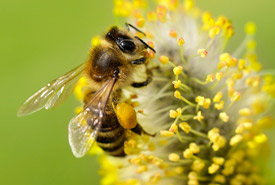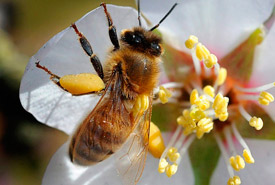Understanding the buzz of bees

Honey bee (Photo from Bees Matter)
For residents of northern Alberta, the coming of spring is never a guarantee of the mild weather it suggests; but this year we’ve been pleasantly surprised by the seasonal warmth. The bees here have also appreciated the early thaw, with many opportunities to emerge from their winter hibernation.
This period of revival is also a sign for things to come at the Grande Prairie Regional College National Bee Diagnostic Centre - Technology Access Centre (GPRC NBDC-TAC).
Although the honey bee is not native to Canada, it has become an integral part of our nation’s economy. For example, in 2016, honey production in Canada was valued at over $157 million. That same year, Statistics Canada estimated that there were nearly 10,000 beekeepers nationwide — a number that has steadily increased over the last decade. The influx of new beekeepers has produced a demand for beekeeping management resources, including diagnostic testing to assess bee health.
To meet this demand, the Grande Prairie diagnostic centre was born in 2013 from a partnership between Grande Prairie Regional College (Research & Innovation) and Agriculture and Agri-Food Canada (Beaverlodge Research Farm). The centre is the first laboratory in Canada to offer diagnostic services exclusively for bees. Openly accessible to the public, our clientele includes beekeepers, industry and academia from across Canada and around the world.

Honey bee (Photo by Michael McCollum/Canadian Press)
Our staff use microbiology, microscopy and molecular techniques to identify pests, pathogens and parasites, such as Nosema, Varroa, American and European foulbrood, that impair bee health. In the last year, we performed over 20,000 diagnostic tests.
We are also involved in several research projects in collaboration with industry, government and academia to assess bee health, including:
National Honey Bee Health Survey: On behalf of the Beekeepers Commission of Alberta and in collaboration with the Manitoba Beekeepers Association, GPRC NBDC-TAC is analyzing bees collected from apiaries nationwide to establish a database of honey bee health for Canada.
Queen Health Evaluation of Imported and Local Stock: Honey bee stock purchased from leading foreign producers (Australia, California, Chile and Hawaii) and several Canadian provinces is assessed for health, based on sperm count and viability, and the presence of pathogens.
Health of Bee Pollinators in Canadian Agriculture: GPRC NBDC-TAC is performing analyses for this project, led by Dr. Stephen Pernal (AAFC-Beaverlodge,) to determine viruses affecting both wild and commercial bee populations.
BeeOMICS Project: GPRC NBDC-TAC is assisting Dr. Leonard Foster (University of British Columbia) and Dr. Amro Zayed (York University) with testing for Nosema, Chritidia and a panel of viruses for the Genome Canada project, "Sustaining and Securing Canada’s Honey Bees using ‘Omic Tools.’’ The goal of the project is to selectively breed bees based on 12 economically valuable traits in the future; this will enable beekeepers to quickly and cost effectively breed disease-resistant productive bee colonies that are better able to survive harsh Canadian winters.
Our staff has been working hard this winter to process samples from the research projects mentioned above. Now that the bees are flying again, we too are looking forward to emerging from the lab and getting back in the field.
On a smaller scale, even if you don’t keep bees, there are ways you too can help bee populations. For example, planting “bee-friendly” plants in your garden will provide additional pollen and habitat for bees. By being mindful of bee health on all levels, we can ensure these important pollinators have a more stable future — and us too. In addition to the honey/bee product market, bee (and insect) pollination is critical for the performance of key food crops that we rely on.
If you are interested in learning more about what we are doing to support apiculture in Canada, visit our website. You can also see what we are up to via our Facebook page.


